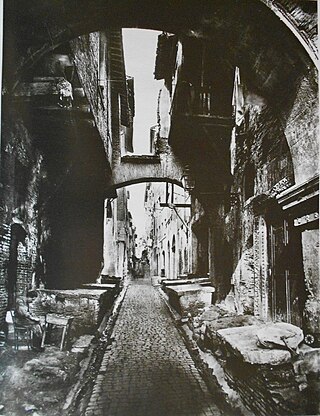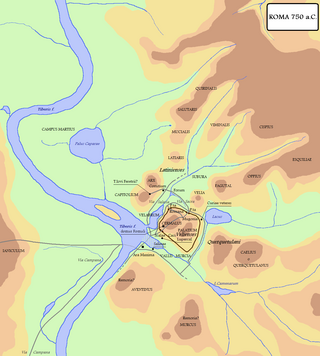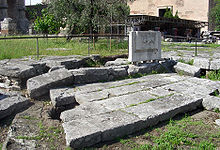
The founding of Rome was a prehistoric event or process later greatly embellished by Roman historians and poets. Archaeological evidence indicates that Rome developed from the gradual union of several hilltop villages during the Final Bronze Age or early Iron Age. Prehistoric habitation of the Italian Peninsula occurred by 48,000 years ago, with the area of Rome being settled by around 1600 BC. Some evidence on the Capitoline Hill possibly dates as early as c. 1700 BC and the nearby valley that later housed the Roman Forum had a developed necropolis by at least 1000 BC. The combination of the hilltop settlements into a single polity by the later 8th century BC was probably influenced by the trend for city-state formation emerging from ancient Greece.

Marcus Curtius is a mythological young Roman who offered himself to the gods of Hades. He is mentioned shortly by Varro and at length by Livius. He is the legendary namesake of the Lacus Curtius in the Roman Forum, the site of his supposed sacrifice.

The Sabines (, SAY-bynes,, SAB-eyens; Latin: Sabini; Italian: Sabini were an Italic people who lived in the central Apennine Mountains of the ancient Italian Peninsula, also inhabiting Latium north of the Anio before the founding of Rome.

Tullus Hostilius was the legendary third king of Rome. He succeeded Numa Pompilius and was succeeded by Ancus Marcius. Unlike his predecessor, Tullus was known as a warlike king who, according to the Roman historian Livy, believed the more peaceful nature of his predecessor had weakened Rome. It has been attested that he sought out war and was even more warlike than the first king of Rome, Romulus. Accounts of the death of Tullus Hostilius vary. In the mythological version of events Livy describes, he had angered Jupiter who then killed him with a bolt of lightning. Non-mythological sources on the other hand describe that he died of plague after a rule of 32 years.

Marcus Terentius Varro was a Roman polymath and a prolific author. He is regarded as ancient Rome's greatest scholar, and was described by Petrarch as "the third great light of Rome". He is sometimes called Varro Reatinus to distinguish him from his younger contemporary Varro Atacinus.

In Roman legend, Tarpeia, daughter of the Roman commander Spurius Tarpeius, was a Vestal Virgin who betrayed the city of Rome to the Sabines at the time of their women's abduction for what she thought would be a reward of jewelry. She was instead crushed to death by Sabine shields and her body cast from the southern cliff of Rome's Capitoline Hill, thereafter called after her the Tarpeian Rock.

The Forum Piscarium was the fish market of ancient Rome, north of the Roman Forum, between the Sacra Via and the Argiletum. It was burned in 210 BC and rebuilt the next year. In 179 BC it was incorporated in the general Macellum, built by Marcus Fulvius Nobilior in the same region.

The Rape of the Sabine Women, also known as the Abduction of the Sabine Women or the Kidnapping of the Sabine Women, was an incident in the legendary history of Rome in which the men of Rome committed a mass abduction of young women from the other cities in the region. It has been a frequent subject of painters and sculptors, particularly since the Renaissance.

The Temple of Jupiter Stator was a sanctuary at the foot of the Palatine Hill in Rome. In Roman legend, it was founded by King Romulus, honoring a pledge he had made during a battle between the Romans and the Sabines. However, no temple was actually built on the site until the early 3rd century BC.

Romulus was the legendary founder and first king of Rome. Various traditions attribute the establishment of many of Rome's oldest legal, political, religious, and social institutions to Romulus and his contemporaries. Although many of these traditions incorporate elements of folklore, and it is not clear to what extent a historical figure underlies the mythical Romulus, the events and institutions ascribed to him were central to the myths surrounding Rome's origins and cultural traditions.

Alba Longa was an ancient Latin city in Central Italy in the vicinity of Lake Albano in the Alban Hills. The ancient Romans believed it to be the founder and head of the Latin League, before it was destroyed by the Roman Kingdom around the middle of the 7th century BC and its inhabitants were forced to settle in Rome. In legend, Romulus and Remus, founders of Rome, had come from the royal dynasty of Alba Longa, which in Virgil's Aeneid had been the bloodline of Aeneas, a son of Venus.
Hostus Hostilius was a Roman warrior in the time of Romulus, and the grandfather of Tullus Hostilius, the third Roman king.
Mettius is a Latin praenomen, or personal name, which was used in pre-Roman times and perhaps during the early centuries of the Roman Republic, but which was obsolete by the 1st century BC. The feminine form is Mettia. The patronymic gens Mettia was derived from this praenomen. The name was rare in historical times, and not regularly abbreviated.

The gens Curtia was an ancient but minor noble family at Rome, with both patrician and plebeian branches. The only member of the gens invested with the consulship under the Republic was Gaius Curtius Philo, in 445 BC. A few Curtii held lesser magistracies during the Republic, and there were two consuls suffectus in imperial times. However, the gens is best remembered from a series of legends dating from the traditional founding of the city to the early Republic.
Quintus Servilius Priscus was a Roman statesman who served as Consul in 468 BC and 466 BC.

In Roman mythology, the Battle of the Lacus Curtius was the final battle in the war between the Roman Kingdom and the Sabines following Rome's mass abduction of Sabine women to take as brides. It took place during the reign of Romulus, near the Lacus Curtius, future site of the Roman Forum.
The gens Geminia was a plebeian family at Rome. The only member of this gens to hold any of the higher offices of the Roman state under the Republic was Gaius Geminius, praetor in 92 BC.

Gaius Curiatius Philo or Chilo was putatively one of the two Roman consuls in 445 BC, during the early Republic. According to the historian Livy, both he and his colleague in office, Marcus Genucius, unsuccessfully opposed the law of the tribune Gaius Canuleius which allowed intermarriage between patricians and plebeians. He then presided over the elections of the first ever consular tribunes, only to have them invalidated by committing a mistake in the taking of the auspices.

The Battle of the Isère River took place near the modern day French town of Valence at the confluence of the Isère and Rhône rivers. A first confrontation had been won by Gnaeus Domitius Ahenobarbus at the Battle of Vindalium, further south in the Rhône Valley, before Ahenobarbus and Quintus Fabius Maximus Allobrogicus joined their forces, defeating a confederation of Allobroges, Arverni and some Salluvii warriors at the Isère River.


















